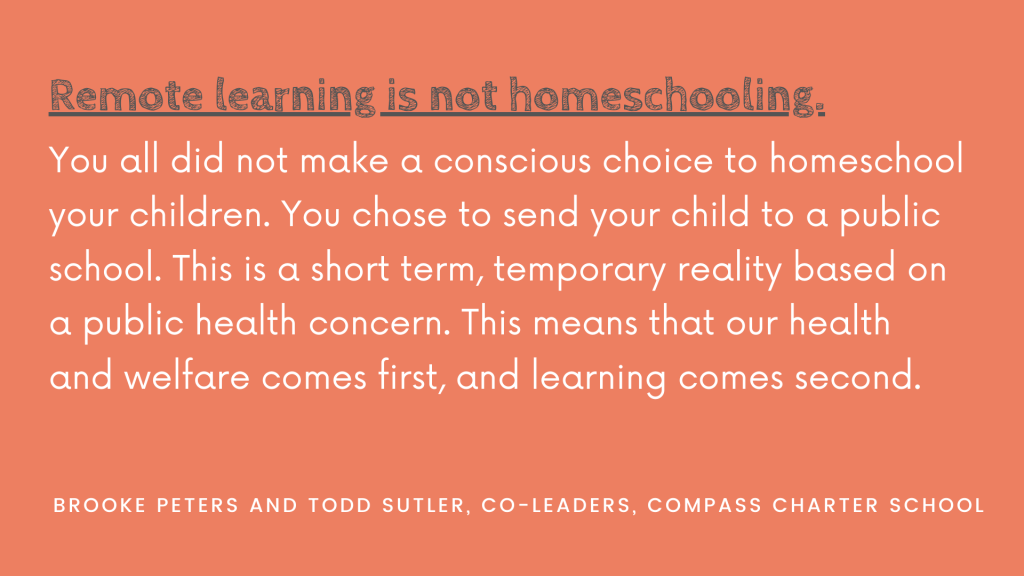
In one of the first COVID-19-related updates for families, Brooke Peters and Todd Sutler, co-leaders of my school in Brooklyn, wrote:
Nine weeks later, “most good, least harm” has been my lifeboat, words to hang on to as I navigate personal and professional waters.
I asked Brooke, as well as Stephanie Penberthy, our school social worker, to help think about practices that do the most good and the least harm when it comes to communication with caregivers, virtual meetings, and remote writing instruction.
Before sharing, know that my colleagues and I continue to have more questions than answers. We habitually read the feedback (formal and observational) and adjust, better aligning the work with our beliefs and purposes as progressive educators.
Remote instruction at our school has evolved several times already based on what we are learning, and we imagine it will continue to do so the longer we must teach this way. As we tunnel deeper and deeper toward our roots, we are committed to resurfacing stronger.
Brooke: Teaching is a political act. Before the pandemic, educators spent more time with children, leaving families to trust the values in place at the school. Now, the power has shifted, as caregivers are spending the most time with children. We must explicitly state the values behind the work we share. In doing so, we’re forming two-way partnerships and hopefully will come out of this with a true community feeling.
Stephanie: Two of the most important elements of a trauma-informed approach are clear boundaries and consistency. We can set boundaries for ourselves when it comes to communication, which will open space for families to do the same. Aim for consistency in terms of frequency, time of day, and platform.
Brooke: We’re enduring a shared trauma that kids and families will likely remember forever. What can we do to make this time restorative? Revisiting Maslow’s hierarchy of needs, the number one goal is that families have what they need and are safe. Then comes love and belonging. We must consider the role of a school, especially a community-oriented school. There is a need for schools to hold space for everyone as whole beings, asking, What is the greater good for our community, and how does it transfer to larger communities?
Stephanie: We need to hold space for families to talk to kids about COVID-19, for adults to talk about how we/they are processing, and for kids to talk about how they are processing. We can’t undue trauma, but we can take a trauma-informed approach. We can assume that everyone has a relationship with trauma. For some people, this is a direct experience. For others, it is hearing a story from a friend or watching a news story that is filled with sadness. The goal is to help everyone feel safe. Kids and caregivers and educators will make mistakes, because we’re human, but we’ll still be there for one another. We’ll always care.
Brooke: Remote instruction is proving that one-size education doesn’t work for everyone. Try to provide as much grade-level content as possible in the most purposeful, authentic, and humane way — with access points and resources. We can also model the idea that society has to take care of itself right now, the best way that it can. It’s not just self-care, it’s self-preservation. If we aren’t making the work sustainable to ourselves, it’s harder to translate to families and students and we’re holding the weight.
Stephanie: Try to find a balance of loose-tight — enough tightness and structure that people feel safe enough for there to be some looseness. Families should know, “This doesn’t work for my family today, and that’s okay, because it will still be there tomorrow. It will always be there.” The school’s response should be consistent: do what you can.
Do the most good and the least harm. For caregivers. For children. For yourself.







Thank you. May I share your graphic with colleagues?
LikeLiked by 1 person
Please do!
LikeLike
Thank you!
LikeLike
In the midst of confusing expectations from school and from homes, this post served as a much-needed reset this morning. Thank you.
LikeLiked by 1 person
So important to keep working on the balance of life every day…
LikeLiked by 1 person
This is great advice/suggestions. I love the graphics.
LikeLiked by 1 person
Thanks for this thorough and informative post.
LikeLiked by 1 person